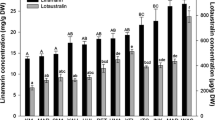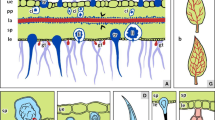Abstract
This communication reviews recent biochemical studies ofl-canavanine that have provided significant understanding of the interaction between the seed ofDioclea megacarpa (Leguminosae) and the bruchid beetleCaryedes brasiliensis (Bruchidae). The principal biochemical bases are proposed for: canavanine toxicity, the ability of the beetle larvae to adapt to its presence, the metabolic sequestration and detoxification of ammonia, and the potential amplification by microbial symbionts of the beetle's abilities to adapt to toxic components of the host.
Similar content being viewed by others
References
Applebaum, S.W. 1964. Physiological aspects of host specificity in the bruchidae I. General considerations of developmental compatibility.J. Insect Physiol. 10:783–788.
Bell, E.A., andJanzen, D.H. 1971. Medical and ecological considerations ofl-dopa and 5-HTP in seeds.Nature 229:136–137.
Buck, J.B. 1953. Physical properties and chemical composition of insect blood, pp. 147–190,in K.D. Roeder (ed.). Insect Physiology. John Wiley & Sons, New York.
Cochran, D.G. 1975. Excretion in insects, pp. 177–281,in D.J. Candy and B.A. Kilby (eds.). Insect Biochemistry and Function. Chapman and Hall, London.
Garcia, I., Roche, J., andTrixier, M. 1956. Sur le metabolisms de l'arginine chez les insectes.Bull Soc. Chim. Biol. 38:1423–1433.
Harborne, J.B. 1982. Introduction to Ecological Biochemistry, 2nd ed. Academic Press, New York, 278 pp.
Harry, P., Dror, Y., andApplebaum, S.W. 1976. Arginase activity inTribolium castaneum and the effect of canavanine.Insect Biochem. 6:273–279.
Janzen, D.H. 1971. Escape of juvenileDioclea megacarpa (Leguminosae) vines frmo predators in a deciduous tropical forest.Am. Nat. 105:97–112.
Janzen, D.H. 1981. The defenses of legumes against herbivores, pp. 951–977,in R. M. Polhill and P.H. Raven (eds.). Advances in Legume Systematics. Her Majesty's Printing Office, London, England.
Janzen, D.H., andMartin, P.S. 1981. Neotropical anachronisms: The fruits the gomphotheres ate.Science 215:19–27.
Kammer, A., Dahlman, D.L., andRosenthal, G.A. 1978. Effects of the non-protein amino acidsl-canavanine andl-canaline on the nervous system of the moth,Manduca sexta (L.).J. Exp. Biol. 75:123–132.
Kito, K., Sanada, Y., andKatunuma, N. 1978. Mode of inhibition of ornithine amino-transferase byl-canaline.J. Biochem. 83:201–206.
Mullins, D.E., andCochran, D.G. 1972. Nitrogen excretion in cockroaches: uric acid is not a major product.Science 177:699–700.
Mullins, D.E., andCochran, D.G. 1976. A comparative study of nitrogen excretion in twenty-three cockroach species.Comp. Biochem. Physiol. 53A:393–399.
Opler, P.A., 1979. Insects of American chestnut: possible importance and conservation concerns, pp. 83–85,in W. McDonald (ed.). The American Chestnut Symposium. West Virginia University Press.
Pines, M., Rosenthal, G.A., andApplebaum, S.W. 1981. In vitro incorporation ofl-canavanine into vitellogenin of the fat body of the migratory locustLocusta migratoria migratorioides.Proc. Natl. Acad. Sci. U.S.A. 78:5480–5483.
Porembska, Z., andMochnacka, I. 1964. The ornithine cycle inCelerio euphorbiae.Acta Biochim. Pol. 11:109–117.
Powning, R.F. 1953. Studies on the digestion of wool by insects. III. The significance of certain excretory products of the clothes moth,Tineola bissellella and the red carpet beetle,Attagenus piceus.Aust. J. Biol. Sci. 6:109–117.
Razet, P. 1966. Les elements terminaux du catobolisme azote chez les insectes.Ann. Biol. 5:43
Rehr, S.S., Janzen, D.H., andFeeny, P.P. 1973.l-Dopa in legume seeds: A chemical barrier to insect attack.Science 181:81–82.
Rosenthal, G.A. 1974. The interrelationship of canavanine and urease in seeds of the Lotoideae.J. Exp. Bot. 25:609–613.
Rosenthal, G.A. 1977a. The biological effects and mode of action ofl-canavanine, a structural analogue ofl-arginine.Q. Rev. Biol. 52:155–178.
Rosenthal, G.A. 1977b. Nitrogen allocation forl-canavanine synthesis and its relationship to chemical defense of the seed.Biochem. System. Ecol. 5:219–220.
Rosenthal, G.A. 1982. Plant Nonprotein Amino and Imino Acids. Biological, Biochemical, and Toxicological Properties. Academic Press, New York, 273 pp.
Rosenthal, G.A., andDahlman, D.L. 1975. Non-protein amino acid-insect interactions II. Effects of canaline on growth and development of the tobacco hornworm,Manduca sexta L. (Sphingidae).Comp. Biochem. Physiol. 52A:105–108.
Rosenthal, G.A. andJanzen, D.H. 1979. Herbivores: Their Interaction with Secondary Plant Metabolites. Academic Press, New York, pp. 353–385.
Rosenthal, G.A., andJanzen, D.H. 1981. Nitrogenous excretion by the terrestrial seed predator,Caryedes brasiliensis.Biochem. Syst. Ecol. 9:219–220.
Rosenthal, G.A., andJanzen, D.H. 1983. Avoidance of nonprotein amino acid incorporation into protein by the seed predator,Caryedes brasiliensis (Bruchidae).J. Chem. Ecol. (in press).
Rosenthal, G.A., Dahlman, D.L., andJanzen, D.H. 1976. A novel means for dealing withl-canavanine, a toxic metabolite.Science 192:256–258.
Rosenthal, G.A., Janzen, D.H., andDahlman, D.L. 1977. Degradation and detoxification of canavanine by a specialized seed predator.Science 196:658–660.
Rosenthal, G.A., Hughes, C., andJanzen, D.H. 1982.l-Canavanine, a dietary source for the seed predatorCaryedes brasiliensis (Bruchidae).Science 217:353–355.
Schoffeniels, E., andGilles, R. 1970. Nitrogenous constitutents and nitrogen metabolism in arthropods, pp. 199–227,in M. Florkin and B.T. Scheer (eds.). Chemical Zoology, Vol. 5A. Academic Press, New York.
Author information
Authors and Affiliations
Rights and permissions
About this article
Cite this article
Rosenthal, G.A. Biochemical adaptations of the bruchid beetle,Caryedes brasiliensis tol-canavanine, a higher plant allelochemical. J Chem Ecol 9, 803–815 (1983). https://doi.org/10.1007/BF00987806
Received:
Revised:
Issue Date:
DOI: https://doi.org/10.1007/BF00987806




